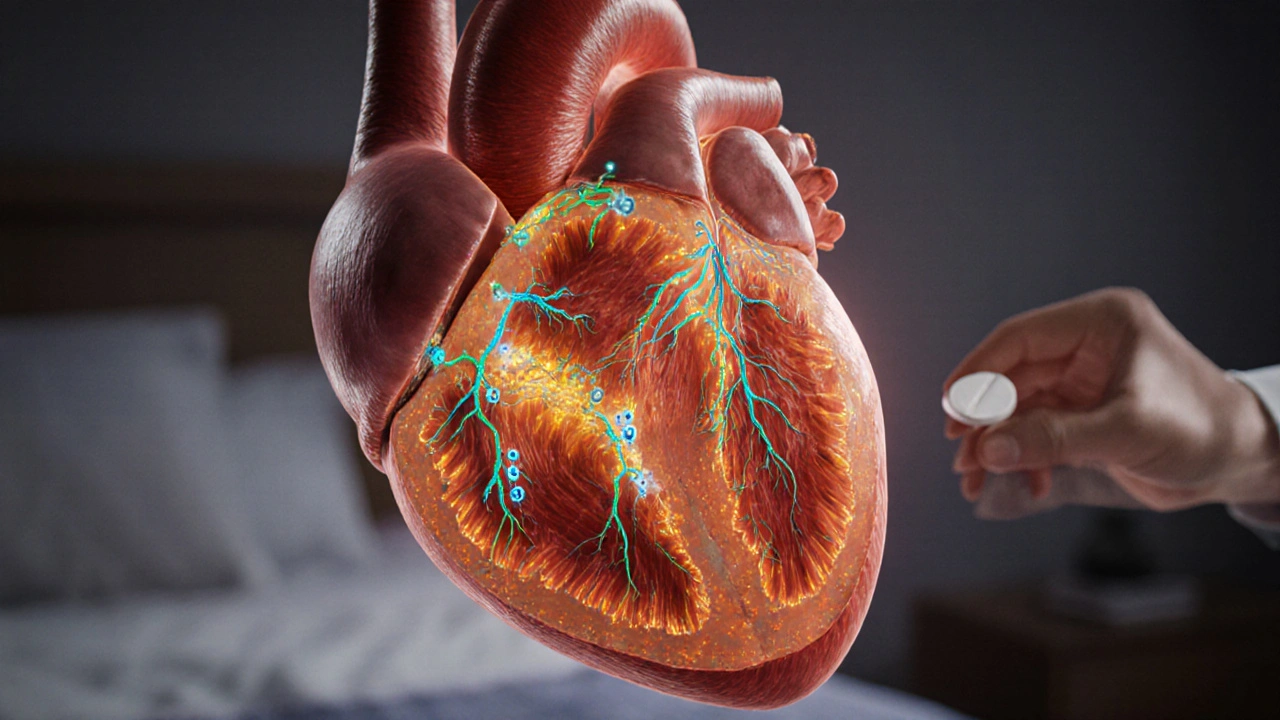Vastarel vs. Anti-Anginal Alternatives Comparison Tool
Vastarel (Trimetazidine)
Metabolic modulator that shifts heart metabolism to glucose oxidation.
Ranolazine
Blocks late sodium current, reduces intracellular calcium overload.
Nicorandil
Hybrid nitrate-like vasodilator that opens potassium channels.
Ivabradine
Selective funny-channel inhibitor that lowers heart rate.
Metoprolol
Beta-blocker that reduces heart rate and oxygen demand.
Amlodipine
Calcium-channel blocker causing arterial vasodilation.
Side Effect Comparison Table
| Drug | Common Side Effects | Serious Risks | Contraindications |
|---|---|---|---|
| Vastarel | Dizziness, headache, GI upset | Rare movement disorders, QT prolongation | Severe hepatic impairment, hypersensitivity |
| Ranolazine | Nausea, constipation, dizziness | QT prolongation, hepatic dysfunction | CYP3A4 inhibitors |
| Nicorandil | Headache, flushing, skin lesions | Severe hypotension, hyperkalemia | Severe aortic stenosis, active ulcers |
| Ivabradine | Visual phosphenes, bradycardia | Severe bradyarrhythmias, atrial fibrillation | HR < 60 bpm, sick-sinus syndrome |
| Metoprolol | Fatigue, cold extremities | Bronchospasm, severe bradycardia | Severe asthma, AV block |
| Amlodipine | Peripheral edema, gum hyperplasia | Severe hypotension with vasodilators | Severe aortic stenosis, unstable angina |
| Isosorbide Mononitrate | Headache, dizziness | Severe hypotension, reflex tachycardia | Severe anemia, elevated ICP |
Key Takeaways
- Vastarel (trimetazidine dihydrochloride) works by shifting heart metabolism from fatty acids to glucose, improving efficiency during ischemia.
- Ranolazine, nicorandil, and ivabradine are the most common prescription alternatives; each has a distinct mechanism and side‑effect profile.
- Beta‑blockers and calcium‑channel blockers remain first‑line for many patients, but they act on heart rate and vessel tone rather than metabolism.
- Choosing the right drug depends on symptom severity, comorbidities, drug interactions, and how the patient tolerates each class.
- Regular monitoring of blood pressure, ECG, and renal function is essential regardless of the chosen therapy.
If you’re trying to decide whether Vastarel fits your treatment plan, you’ve come to the right place. Below is a plain‑language, side‑by‑side look at trimetazidine and the most widely used alternatives for chronic angina and related cardiac conditions.
What Is Vastarel?
Vastarel is the brand name for trimetazidine dihydrochloride, a metabolic agent approved in many countries for relieving angina pectoris. It is also known by the alternate name Trimetazidine. The drug was first introduced in the 1990s and is marketed in Europe, Asia, and parts of South America.
Vastarel is taken orally, usually 20mg three times a day, and is intended for patients whose angina persists despite optimal use of first‑line agents like beta‑blockers.
How Trimetazidine Works
Trimetazidine belongs to the class of cellular metabolic modulators. Its core action is to inhibit the enzyme 3‑keto‑acyl‑CoA thiolase, which forces cardiac cells to rely more on glucose oxidation than fatty‑acid oxidation. Because glucose yields more ATP per oxygen molecule, the heart can produce the same amount of energy with less oxygen, easing the mismatch that causes chest pain during stress.
Key pharmacologic facts:
- Onset of symptom relief: 1-2 weeks.
- Peak plasma concentration: ~2hours after ingestion.
- Half‑life: 6hours; steady‑state reached in 2-3 days.
- Excreted unchanged in urine.

Common Prescription Alternatives
Below are the main drugs doctors consider when Vastarel isn’t suitable or when they want a different therapeutic angle.
Ranolazine is an anti‑anginal that blocks the late sodium current, reducing intracellular calcium overload and improving myocardial relaxation.
Typical dose: 500mg twice daily, titrated to 1000mg BID if tolerated. Benefits include a rapid onset (within days) and a relatively low impact on heart rate or blood pressure.
Nicorandil is a hybrid nitrate‑like vasodilator that opens potassium channels, producing both arterial dilation and venous runoff.
Given as 5-10mg three times a day. It’s especially useful for patients with microvascular angina because it improves coronary flow reserve.
Ivabradine is a selective funny‑channel (If) inhibitor that lowers heart rate without affecting contractility or blood pressure.
Prescribed at 5mg twice daily, adjusted to 7.5mg BID. Works best in patients who cannot tolerate beta‑blockers or need additional heart‑rate control.
Metoprolol is a cardio‑selective beta‑blocker that reduces heart rate, myocardial contractility, and oxygen demand.
Common doses range from 25mg to 200mg daily, often split into two doses. It remains first‑line because of strong evidence for mortality reduction.
Amlodipine is a dihydropyridine calcium‑channel blocker that causes arterial vasodilation, lowering afterload.
Typical dose: 5-10mg once daily. Its long half‑life (30-50hours) makes it handy for patients who need steady blood‑pressure control.
Isosorbide mononitrate is a nitrate that donates nitric oxide, leading to venous dilation and reduced preload.
Administered 20-80mg once daily, often at night to avoid early‑morning headaches.
Side‑Effect Profiles at a Glance
| Drug | Common Side‑Effects | Serious Risks | Contra‑indications |
|---|---|---|---|
| Vastarel | Dizziness, headache, gastrointestinal upset | Rare movement disorders (parkinsonism‑like), QT prolongation | Severe hepatic impairment, known hypersensitivity |
| Ranolazine | Nausea, constipation, dizziness | QT prolongation, severe hepatic dysfunction | Concurrent use with potent CYP3A4 inhibitors |
| Nicorandil | Headache, flushing, ulcerative skin lesions | Severe hypotension, hyperkalemia | Severe aortic stenosis, active ulcer disease |
| Ivabradine | Visual phosphenes, bradycardia | Severe bradyarrhythmias, atrial fibrillation | Resting HR < 60bpm, sick‑sinus syndrome |
| Metoprolol | Fatigue, cold extremities | Bronchospasm in asthmatics, severe bradycardia | Severe asthma, second‑ or third‑degree AV block |
| Amlodipine | Peripheral edema, gum hyperplasia | Severe hypotension when combined with other vasodilators | Severe aortic stenosis, unstable angina |
| Isosorbide mononitrate | Headache, dizziness | Severe hypotension, reflex tachycardia | Severe anemia, intracranial pressure elevation |
When to Pick Vastarel Over the Rest
Consider Vastarel if you meet one or more of these conditions:
- You have persistent angina despite a good dose of beta‑blocker and a calcium‑channel blocker.
- You need a drug that doesn’t lower blood pressure or heart rate, which is useful for patients with borderline hypotension.
- You’re already on a nitrate and want an additive metabolic effect without extra vasodilation.
- You have contraindications to Ranolazine (e.g., severe hepatic disease) or Nicorandil (active ulcer disease).
On the flip side, avoid Vastarel if you have a history of movement disorders, are pregnant, or have uncontrolled diabetes (as the shift toward glucose metabolism can affect glycemic control).

Choosing an Alternative: Decision Checklist
- Is heart‑rate reduction a priority? Ivabradine or a beta‑blocker might be better.
- Do you need vasodilation to relieve preload? Isosorbide mononitrate or Nicorandil could help.
- Are you dealing with microvascular angina? Nicorandil shows the strongest evidence.
- Concerned about QT prolongation? Stay clear of both Vastarel and Ranolazine if you have baseline prolongation.
- Kidney function impaired? All the listed drugs are primarily hepatic or neutral; monitor renal labs but none require dose reduction solely for eGFR <30ml/min.
Practical Tips for Patients Starting a New Anti‑Anginal
- Take the medication with food when possible; this reduces gastrointestinal upset for most oral agents.
- Track chest‑pain episodes in a diary - note time, activity, and relief time. This helps your doctor gauge effectiveness.
- Schedule a baseline ECG before starting and repeat after 2-4 weeks, especially for drugs known to affect QT.
- Never combine two nitrates (e.g., isosorbide dinitrate + isosorbide mononitrate) - the risk of severe hypotension spikes.
- If you notice unexplained tremors, slowed movement, or visual disturbances, contact your clinician-these can signal rare trimetazidine‑related issues.
Bottom Line
Vastarel offers a unique metabolic angle that can be a game‑changer for patients stuck on conventional therapy. However, its niche means you’ll often weigh it against drugs with broader evidence bases like beta‑blockers, calcium‑channel blockers, or the newer sodium‑current blocker Ranolazine. Use the comparison table and checklist above to discuss with your cardiologist which profile fits your health picture best.
Frequently Asked Questions
Can I take Vastarel with a beta‑blocker?
Yes. Vastarel does not affect heart rate or blood pressure, so it can be added to a stable dose of a beta‑blocker when angina remains uncontrolled.
How long does it take for Vastarel to reduce chest pain?
Most patients notice improvement after 1-2 weeks of consistent dosing, though full benefit may take up to a month.
Is trimetazidine safe for people with diabetes?
Trimetazidine shifts metabolism toward glucose, which can modestly affect blood‑sugar levels. Diabetics should monitor glucose more closely when starting the drug.
Why might my doctor prefer Ranolazine over Vastarel?
Ranolazine has a larger body of randomized‑controlled trial data in Western populations and works quickly without affecting metabolism, which some clinicians find more predictable.
Can I switch from Nicorandil to Vastarel without a washout period?
Because both drugs have different mechanisms and half‑lives, most physicians recommend a short 24‑hour gap to avoid overlapping vasodilatory effects.


Honestly this tool feels like a glorified sales brochure.
Wow, I never thought I'd see a comparison chart that looks like a pop‑up ad from 2005. The colors are bright enough to scare a neon sign. The way they slotted everything into neat boxes feels sooo organized, yet somehow all the nuance is missing. I’m trying to stay neutral but the drama of the layout is just too much. Gonna need a coffee after scrolling through this.
The present exposition of anti‑anginal pharmacotherapy manifests a quintessentially reductionist paradigm, wherein the epistemic complexity of myocardial ischemia is distilled into a tabular juxtaposition.
Such an approach, while pedagogically convenient, betrays a latent ontological naiveté that risks obfuscating mechanistic subtleties.
Trimetazidine's metabolic modulation, as delineated herein, is indeed a pivotal therapeutic vector, yet the authors neglect to underscore its kinetic profile vis‑à‑vis hepatic first‑pass metabolism.
Ranolazine's interaction with the CYP3A4 axis, for instance, warrants a granular discussion that is conspicuously absent.
Moreover, the side‑effect tableau erroneously aggregates disparate adverse event spectra without stratifying by dosage tier.
The omission of population‑specific pharmacogenomic considerations further impoverishes the analysis.
From a clinical decision‑making perspective, the physician requires a hierarchy of evidence, not a flat enumeration of bullet points.
A meta‑analytic synthesis of randomized controlled trials would have conferred a more robust evidentiary scaffold.
The authors also neglect to contextualize the QT‑prolongation liability of both trimetazidine and ranolazine within the framework of polypharmacy.
In the realm of real‑world practice, adherence patterns, cost‑effectiveness ratios, and formulary restrictions are paramount.
The comparative tool would benefit from integrating these health‑economic parameters.
Furthermore, the visual ergonomics of the interface, though aesthetically appealing, lack accessibility accommodations for color‑vision deficiency.
The reliance on hover‑triggered disclosures may impede users operating assistive technologies.
A more inclusive design philosophy would enhance the utility across diverse patient cohorts.
In summation, while the compendium serves as a cursory reference, its scholarly rigor is insufficient for advanced clinical deliberation.
Future iterations should aspire to a multidimensional matrix that reconciles pharmacodynamics, pharmacokinetics, and patient‑centered outcomes.
Look at the metabolic shift angle it’s clever but the data presentation feels thin the mechanism is solid yet the real‑world implications are glossed over you need to consider drug interactions especially with CYP pathways also the QT issue deserves a deeper dive the table could use more granularity on dosing schedules we can’t ignore the cost factor either
The comparison does a decent job of summarizing the primary mechanisms of each agent. However, it omits the prevalence of contraindications in patients with renal impairment. Including that data would help clinicians tailor therapy more accurately. Overall, the format is clear and user‑friendly.
Oh great, another shiny chart that pretends to solve my prescribing dilemmas. Because nothing says “clinical insight” like a hover effect. I guess we’re all supposed to trust the design over the data. Good luck navigating that on a phone.
I appreciate the effort put into compiling this comprehensive side‑effect matrix. It provides a valuable snapshot for clinicians counseling patients about potential risks. The inclusion of both common and serious adverse events is particularly helpful. Hopefully future updates will incorporate emerging evidence on combination therapy.
Wow, this layout is so sleek 😍! Love the way each drug card pops up with details 📊. Makes reading about angina meds way less boring 🙌. Can’t wait to try the tool on my tablet 📱.
Nice work on making a complex topic more approachable! The side‑effect tables are clear, and the “Key Takeaways” really help distill the info. Keep it up, and maybe add a quick FAQ for beginners.
Well, the table certainly enumerates the adverse‑event profiles, albeit in a fashion that reads like a legal disclaimer. One might argue the lack of nuance diminishes its practical value. Nonetheless, the visual polish is commendable.
Looks solid, but needs more on drug interactions.
Honestly, this tool feels like a designer’s playground, where the colors scream louder than the clinical relevance. It’s pretty, but pretty doesn’t prescribe. Maybe sprinkle some real‑world case snippets to spice it up.
I find the metabolic focus on trimetazidine interesting, though the chart could benefit from clearer labeling. The side‑effect rows are helpful. Overall, a useful reference.
Esteemed colleagues, the presented comparative analysis exhibits a commendable breadth of pharmacological detail. Nevertheless, the omission of longitudinal outcome data constitutes a noteworthy lacuna. Incorporation of such metrics would undoubtedly augment the scholarly merit of this resource. I look forward to forthcoming revisions.
Great, another shiny chart that pretends to be deep.
Thanks for sharing this tool! It’s a great starting point for patients wanting to understand their options. Adding patient‑story snippets could make it even more relatable.
The interface dazzles the eye and yet it whispers of hidden complexities that the casual observer may overlook the minimalistic punctuation mirrors a modern aesthetic but perhaps sacrifices clarity the persistent hover requirement could hinder accessibility especially for those using screen readers the color palette, while vibrant, may not accommodate color‑blind users an expanded legends section could remedy these concerns and provide a richer educational experience for all users
Dear Julie, your observation regarding the labeling precision is astute and merits further discourse. In the realm of pharmacological taxonomy, the vernacular employed must reconcile both scientific rigor and didactic clarity. The current schema, while succinct, occasionally conflates mechanistic descriptors with clinical outcomes, thereby engendering potential ambiguity for the discerning reader. A systematic revision, perhaps employing a tiered nomenclature hierarchy, would ameliorate this dichotomy. Thus, your suggestion aligns with an overarching imperative for didactic excellence.
Good point about the marketing feel. The data itself is solid, just presented in a flashy way. If you focus on the numbers you’ll find the comparisons useful.